Inquiring Minds, Accelerating Change, Enduring Values
As the world shrinks and knowledge expands, new ways of teaching and learning are emerging to meet the challenge of educating leaders for the digital age. Swarthmore is engaging its entire community to plan for this future.
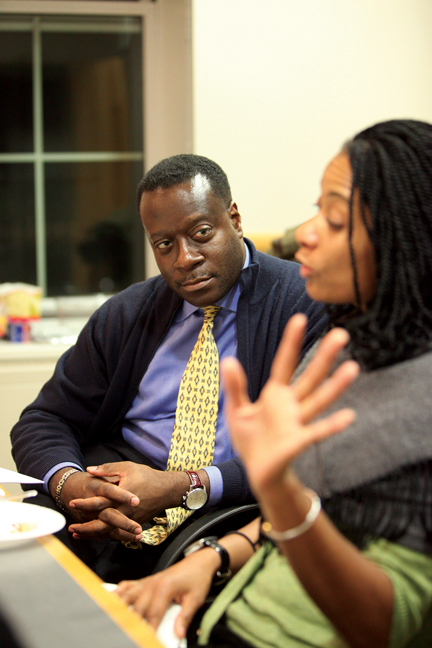
Professor of Political Science Keith Reeves ’88 (left) teaches The Urban Underclass and Public Policy.
MORE THAN 600 COURSES ARE LISTED in the Swarthmore College catalog. Not all are taught each year, but, taken as a whole, the College’s curriculum offers its 1,500 students a stunning array of learning opportunities in the social sciences, natural sciences, and humanities—plus a dozen interdisciplinary minors. Thirty-five departments and programs make Swarthmore’s curriculum both broad and deep.
What courses will Swarthmore’s catalog contain in 2021? Will ancient texts still be discussed around tables of 12? How will curricular innovation be married with tried-and-true pedagogies? Will there be more problem-based courses like Associate Professor of Political Science Keith Reeves’s [’88] honors seminar The Urban Underclass and Public Policy? More opportunities to cross disciplinary boundaries as in Professor of Physics Michael Brown’s first-year seminar on energy? Or greater use of technology and media in courses like Professor of English Literature Betsy Bolton’s Writing Nature: Digital Storytelling?
Even more fundamentally, how will knowledge, teaching, and learning evolve in a rapidly changing—and shrinking—world? Twenty years from now, will students learn through time-honored, face-to-face interactions with professors or in ways as yet untried or even unimagined? Swarthmore graduates will always have good writing, research, and thinking skills, but as lifelong learners in the 21st century, they will employ these competencies in a much different knowledge environment. How, then, will the intellectual attributes of a liberally educated individual be instilled in future Swarthmoreans?
These are among the questions being asked as Swarthmore takes a year and a half to examine itself in preparation for a future that is, in some ways, already upon us. Educators everywhere are asking fundamental questions not only about the “why” of higher education but also about the “who,” “what,” and “how.” At Swarthmore, the examination of how we understand and process knowledge, how we teach and learn, is one of four key areas of inquiry in a strategic planning process that began last fall.* Although this article is not intended to fully answer these questions, some of the forces that will shape those answers have been identified. Here are three examples:
STUDYING REAL-WORLD PROBLEMS
A bright light streaks from the high window of Room 315 in Trotter Hall, cutting into the dark November night like an admonishing finger. It’s time for wakefulness, action, deliberation, reaction. Twelve students gather in the cozy seminar room, readying themselves for four hours of intense discussion, as Professor Reeves prepares to guide them through week 10 of The Urban Underclass.
The problems that these students are studying are among the most challenging, contentious, and complex issues facing the nation today. They include the formation and evolution of northern black ghettos, beginning with the idea of the North as a promised land and progressing to the current economic and social turmoil within inner-city communities and black family structures.
On a Saturday early in the semester, the students—mostly seniors—had walked with Reeves through Swarthmore’s neighboring town, the impoverished city of Chester, Pa., to become better acquainted with some of the cultural and political phenomena and community structures on their syllabus. Reeves facilitates meetings with heads of local organizations or other stakeholders relevant to their projects—and, to help them with research, the students learn how to interpret census data and access other source materials in a methodology workshop led by Social Sciences Librarian Melanie Maksin. Later, they combine knowledge gained in class discussion, their own research, and their connections with people in Chester to create policy analysis exercises (PAE)—independent research papers that describe a problem, analyze its complexities, evaluate previous solutions, and propose new approaches.
Reeves has been teaching this community-based course since 2003. In recent years, several of the students’ 35 to 40-page PAEs have been used by community organizations to help promote or implement change.
Reeves believes that hands-on familiarity with the structures and phenomena they study is crucial for the students if they are to compile meaningful policy suggestions that will be useful to them and the communities they work with.
“I believe in the Hippocratic Oath for policy makers,” he says, “and that is ‘First do no harm,’ which means we have to understand the community, we have to know that there are reciprocal relationships and that the community can offer enormous contributions to aid us as we seek to aid it.”
He employs the time-honored format of the seminar—long, intense debate-like discussions, with each participant expected to contribute to each topic—as a tool to harness the students’ intellectual, critical, and analytical thinking skills as they devise policy ideas and solutions.
EXPLAIN IT TO YOUR ROOMMATE
Also employing the seminar format is Professor Michael Brown, a world-class plasma physicist whose work on spheromaks won the 2008 American Physical Society prize for research in an undergraduate setting. Spheromaks are toroidal rings of plasma used to study magnetic reconnection, a physical process that appears to govern the movements of high-energy matter at the surface of the sun. Brown and his undergraduate research team study the properties of these unusual arrangements of plasma in the Swarthmore Magnetofluids Lab.
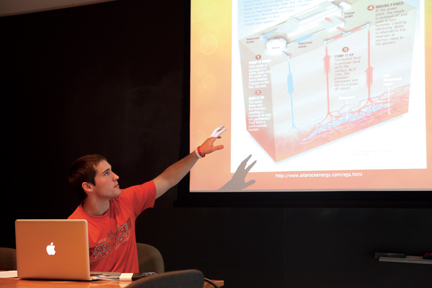
Nick Ciborski ’14 makes a presentation on geothermal energy in a first-year seminar titled Energy, taught by Professor of Physics Michael Brown. First-year seminars allow students—and faculty members—to try out new subjects.
But in fall 2010, in addition to teaching an advanced electrodynamics seminar that includes Maxwell’s field equations, Poynting’s theorem, and four-vector formulation of relativistic electrodynamics, Brown reached outside his high-powered comfort zone to teach a first-year seminar on Energy. The syllabus included the physics and policy of energy in all its forms: thermodynamics and engines; energy sources (fossil fuels, solar, photovoltaic, nuclear); transportation; the electric grid; and climate change. It was the first time he taught the course, which uses as a text Energy, Environment, and Climate by Richard Wolfson ’69, a professor of physics at Middlebury College.
At one of the weekly three-hour meetings of the class in early November, Brown announces that, thus far, he hasn’t exposed the students to a lot of “heavy physics,” but today he wants to show them how a physicist might approach the dual questions of global temperature and the greenhouse effect. For background, the students had read about both in Wolfson’s book, but what Brown goes on to present is more like a physics class than a standard discussion of energy in the environment.
Not only is he teaching a measurable fact—the average temperature of the Earth—he’s inviting the students into another intellectual realm by changing their mode of understanding from merely “learning about” to “learning to be.” The practices and norms of physical science—or any other field, for that matter—are usually accessible only from within the field. The first-year seminar is designed to bring those tacit elements forward, making them part of the learning experience. In their eighth week at Swarthmore, these nine students are being let in on the practice of physics through a real-world problem—global warming—that interests them intrinsically. (Asked later, only one of the nine is considering majoring in physics. Several others, however, say they are interested in environmental studies.)
Brown walks the length of the floor-to-ceiling blackboard and draws a diagram of the sun with, a foot or two to its right, a small circle representing the Earth. “It’s not to scale,” he smiles, noting that the actual radius of the earth-sun system is 1.5×1011 meters. “Just follow along and see if you can understand this well enough to go back to your dorm and explain it to your roommate,” Brown says as the chalk dust begins to fly.
By the time he’s finished nearly an hour later, Brown has filled about 20 linear feet of the chalkboard with diagrams and equations. The students follow the logic of these calculations on a detailed handout, taking a few marginal notes but mostly watching the rational and algebraic elegance of a physicist’s proof.
WRITING NATURE-DIGITALLY
A gentle, repetitive melody played on piano accompanies close-up images of a tiny spider, whose presence one can barely imagine on the thread of its silken web. The soft voice of June Xie ’11, one of nine participants in Professor Betsy Bolton’s course Writing Nature: Digital Storytelling, narrates:
“Following the silken strands playing peek-a-boo in the sunlight, I find
a spider no bigger than the tip of a
ballpoint pen…. I watch as it
escapes on a long strand of silk,
as if it were swinging on a trapeze as
the wind pushes it this way and that way … so small that I couldn’t tell
if it were enjoying the exhilarating moment or just hanging on….”
“Isn’t that beautiful?” exclaims Bolton, as the story ends.
Xie’s narrative is the “homework” for one of three digital storytelling assignments in the course: a personal memoir, using the woods as inspiration; a reflection upon an animal, vegetable, or mineral feature observed there, such as Xie’s spider; and a fragmentary poem, echoing the nature of the Crum as a fragmentary tract of forest—a small sliver of woodland facing challenges to its ecosystem. The students also keep a field journal throughout the semester.
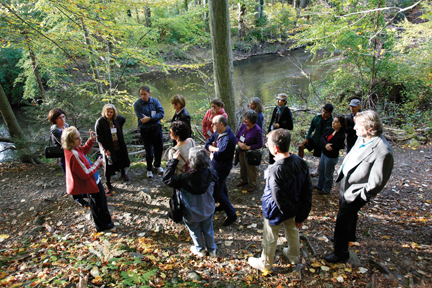
In her course Writing Nature—Digital Storytelling, Professor Betsy Bolton (in red, leading a tour of the woods during Garnet Weekend) aims to “push the students deeper into the woods, beyond being there passively, have them start to learn and observe more deeply, and understand patterns that are affecting places where they are.”
They model their writing on works by authors and poets from around the world who have used nature themes, including W.H. Auden, Rainer Maria Rilke, Italo Calvino, and Pablo Neruda; and they imitate poetic paradigms such as the Persian ghazal form comprising five couplets, scattered and disjointed in content but unified by repetition of the same word at the end of each couplet.
By taking the students into the woods, Bolton extends the classroom and enables them to gather their own impressions of nature as they research and learn about plants, creatures, stones, and other finds in the wild forest tract.
In its previous incarnation, the interdisciplinary course (which also counts toward the environmental studies minor) typically culminated with the compilation of the students’ writings into a book. This changed after Bolton participated in a workshop on digital storytelling—concisely defined by the Center for Digital Storytelling (CDS) as a “short, first-person video-narrative created by combining recorded voice, still and moving images, and music or other sounds. ”
Eric Behrens ’92, associate chief information technology officer for the College, led the team that supported the course’s technology component. Behrens, who has been the principal organizer, coordinator, and advocate for digital storytelling at Swarthmore, worked closely with Bolton to redesign the syllabus and assignments to revolve around digital storytelling.
Borrowing cameras, audio recorders, and GPS devices (on which they input coordinates of their “finds”) from the College’s Media Services department, the students assemble written and visual records that are combined on the computer to form their “papers.” And instead of a book, the archive of the students’ work grows throughout the semester in a blog where students can watch and listen to each others’ work, using the GPS map to locate the exact spots that inspired each composition. In a comments section, they engage in conversation and exchange helpful tips.
Bolton says she is surprised by many of her students’ lack of closeness to nature. She believes that by combining elements of a reading and creative writing class (older forms of expression) with technology (newer forms), she can “push them deeper into the woods, beyond being there passively, have them start to learn and observe more deeply, and understand patterns that are affecting the places where they are. The sexiness of the digital story is my way to bring them out of the computer lab and into the Crum.
“At the same time,” Bolton adds, “there’s been a paradigm shift in our understanding of teaching. I couldn’t teach this course by myself. Its success really depends upon a high level of technical support.”
A semester’s worth of experiences in the Crum, observing, reflecting, reporting, and creating poetry deepens the students’ engagement with and awareness of nature and the environment. In her final journal entry, Rebecca Ringle ’11 writes: “In a year, I know I’ll still be thinking of the creek and all the time I spent there. I love the water, though it’s toxic. I love the way it moves, its consistency but also its constant change …. In five years? Maybe I’ll live near beauty and spend time walking through the woods, identifying what plants I can…. In 15 years, I bet I’ll be looking back at my life in college, wishing for wonderful out-of-the-box classes like this one….”
PRESERVING AND REMIXING TEXTS
Ask Professor of English Literature Craig Williamson—poet, medievalist, and lover of all things Old English—how he feels about the pace of change in a world in which knowledge is stored and transmuted in ever-changing ways, and he’ll tell you that today’s changes are part of a continuum that began one-and-a-half millennia ago, when the oral culture in England was disrupted by missionaries introducing writing tools. Each new segment of literary evolution—from oral culture to writing to printing—brought concerns that the old would be replaced by the new and disappear. Over time, old mixed with new. Oral culture existed alongside the production of manuscripts, which, in turn, continued to exist alongside books and printed matter. The Old English epic poem Beowulf, Williamson says, “although written down, was still read out loud in courts or monasteries. Even in Chaucer’s time, there are pictures of him reading at court. With the advent of the printing press, books made literature more accessible to the public.”
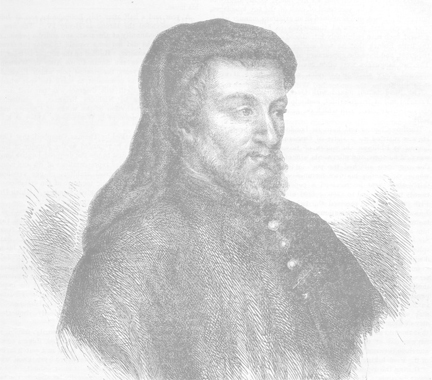
Chaucer
These days, in a course titled Grendel’s Workshop, Williamson, whose new translation of Beowulf will be published in June, introduces students to medieval and early modern literary works in a variety of stages of evolution, beginning with the earliest oral chanted renderings of Beowulf, to John Gardner’s novel Grendel, to modern film versions with the likes of Angelina Jolie portraying the monster Grendel’s mother; and to the character of Hamlet as reconceived by modern British playwright Tom Stoppard in Rosencrantz and Guildenstern Are Dead. Students then have the opportunity to compile their own versions of the works.
“What you hope, whether the story is retold in a film, play, poem, or other mode, is that part of its appeal will be to interest people to return to its original form,” Williamson says. He has also created a website where students can exercise their Old English skills at increasing levels of difficulty by translating a set of Old English Riddles—already in published translation by Williamson—and also listen to him chanting the riddles in the original Old English.
“We’re going into a new age here, where things are being produced and stored electronically and stories are being translated into electronic media, but I believe that this just makes new ways of looking at old texts possible,” he says.
“You don’t need to worry. Chaucer isn’t going anywhere,” Williamson says with a smile. “Teaching literary texts allows us to go back in time and obtain a sense of what it is to be human in another time, another culture, and another language, to expand our knowledge of the world and our sense of humanity.”
THE CHANGING NATURE OF UNDERSTANDING THE WORLD
Our 21st-century understanding of the world seems different from how we understood it in other centuries. Is there merely more to know? Or has the nature of knowledge—its production, transmission, and function in society—evolved such that the nature of academic learning must also be rethought?
John Seely Brown, former chief scientist for Xerox and director of its famed Palo Alto Research Center (PARC), writes with Richard Adler of the Institute for the Future in a 2008 Educause article that for a variety of reasons—not the least of which is the rise of the Internet—“social learning” is replacing “Cartesian learning.”
To Brown and Alder, Cartesian learning achieves the transfer of knowledge from one thinker-owner to another through pedagogy. (The solitary nature of “I think, therefore I am,” is the operative phrase of 17th-century philosopher René Descartes.) Social learning is “based on the premise that our understanding of content is socially constructed through conversations about that content and through grounded interactions, especially with others, around problems or actions.” (“We participate, therefore we are.”)
Although these terms may be new, forms of social learning have long been emphasized at Swarthmore through small classes, study groups, honors seminars, and late-night bull sessions. Swarthmore alumni often say that they learned as much from their fellow students as from their professors—and that this is one of the distinct advantages of the small residential college. (A study by Richard Light of the Harvard Graduate School of Education found that “one of the strongest determinants of student success in higher education—more important than the details of their instructors’ teaching styles—was their ability to form or participate in small study groups.”) Close relationships with faculty members and peer tutoring, such as the quarter-century–old Writing Associates program or the more recent Student Academic Mentors, have long been hallmarks of the face-to-face nature of a Swarthmore education.
Yet 21st-century social learning goes well beyond the traditional modes of collaboration described above. It also includes the ways in which professors bring students into their subjects by showing them how to “be” a physicist as they are studying the content of that field. With a nod to John Dewey’s idea of “productive inquiry,” Brown and Adler say that acquiring “tacit knowledge” is replacing the Cartesian model, under which students might spend years accumulating substantive knowledge before being invited into a “community of practice.”
STUDENTS AND THE NEW SHAPES OF THE WORLD
Today’s students bring to the classroom a diversity of backgrounds and life experiences that were unrepresented a generation ago. Professor of Economics Stephen O’Connell—another member of the Working Group on Knowledge, Teaching, and Learning—who has been teaching at Swarthmore since the 1990s, has observed these changes.
“When I started teaching Development Economics in the mid-1990s, a typical seminar would have a few foreign students—but mainly Americans, most of whom had never traveled in the developing world,” he says. “This semester, I’m teaching two seminars with a total of 24 students. My guess is that about half were born outside the United States—and I believe there are only two Americans who haven’t lived for an extended period in a developing country.”
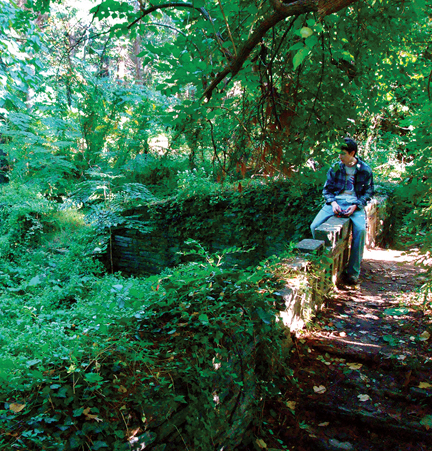
The Crum Woods provides more than rest and recreation for Swarthmore students—it is a living laboratory and literary inspiration.
O’Connell’s point is that, through this diversity, the world has become smaller in a very concrete way for all Swarthmore students. “This creates both challenges and opportunities for me,” he says. “Whereas in the past my own limited life experience was far enough ahead of theirs in terms of concrete exposure to life in poor and developing countries, that’s not the case anymore. On the other hand, the backgrounds they bring with them make for a richer learning environment.”
Even for students without direct international experience, the Internet has so flattened the world for everyone that walls that once limited people’s experiences no longer exist, O’Connell says.
Professor of History Tim Burke agrees. As a scholar of both African history and contemporary American culture, he sees technology as a bridge that connects the classroom with the world beyond the ivory tower. “There are things you can know using social or information technologies that would otherwise have required years of investigative research,” Burke says.
In his course The Image of Africa, he explores how images of Africa as “tribal” have become embedded in Western consciousness—often to the detriment of truly understanding contemporary Africa. Students see this during an e-Bay search using just the keywords “tribal” and “African.”
“They see thousands and thousands of objects that people are bidding on—things people want to collect or have in their homes that they imagine to be ‘tribal African,’” says Burke of the instantly visible stereotyping. “Twenty years ago, seeing this would have required a research project that might have taken three or four years of traveling to collectors’ homes and interviewing people. Now, you a get a good window into the desires and cultural biases of a significant number of people with just two key words and a website.”
Burke, who is a member of the Strategic Planning Working Group on Knowledge, Teaching, and Learning, says that central to any conception of the curriculum during the next 20 years is making academic knowledge publicly valuable and meaningful: “We definitely need more of that kind of understanding—ways to link up what we do, which is so transparent on the Web—with an academic conception of why it matters in society.”
EDUCATING THE "NET GENERATION”
In addition to being more diverse and having greater experience of the world, many students are now so at ease with technology and digital media that they notice it about as much as their parents’ generation noticed light bulbs in their homes. It’s just there, part of the world they inhabit, and this requires educators and technologists to figure out how differently the so-called Net Generation uses technology to learn and to interact with their world. What’s already clear is that they approach information very differently.
According to researchers Diana and James Oblinger, today’s students have greater visual-spatial skills and are “intuitive visual communicators;” learn better through inductive discovery than by being told; have the ability “to shift their attention rapidly from one task to another, and may choose not to pay attention to things that don’t interest them.” If these are accurate descriptors of the NetGen, these three qualities challenge educators who rely on traditional (Cartesian) pedagogies to adapt to new learning styles—a transition that will require attention and support from the College.
In addition, this generation’s social nature and broad connections are inclusive and largely positive; they work easily together in teams where they find it easy to help each other; and they like doing things—especially things that matter in the world. And, in fact, they are paying attention—just in a different way—a way that may actually help them thrive in the Internet age.
John Seely Brown writes: “People my age tend to think that kids who are multiprocessing can’t be concentrating. That may not be true.” At PARC, Seely Brown hired a cadre of 15-year-olds and gave them license to design their own computer-based learning environment. He observed that the teens’ attention span often ranged between 30 seconds and five minutes, which “parallels that of top managers, who operate in a world of fast context-switching. So the short attention spans of today’s kids may turn out to be far from dysfunctional for future work worlds.”
As Swarthmore’s planning process moves forward, Gayle Barton, the College’s chief information technology officer (and also a member of the Strategic Planning Working Group), is tracking these and other trends with a view to future campus needs.
“The pace of change will continue to increase—as will the volume of information and number of options—so we’ll need to have technologists who can help people choose solutions that fit their needs,” she says.
“New tools for communication and self-publishing are becoming increasingly important in the academic arena. Scientists have had literature and data available online for years, but scholars in the humanities and social sciences are also moving in that direction. Students need to be prepared to publish their work online, with audio and video, and texts written for a public audience.”
Another trend might be called the aggregation of knowledge. Where pockets of information were once found in discrete places, the world’s islands of knowledge are now finding their way, with the help of scholars and others, into relationship with each other. It’s almost as if the continents, which drifted apart as the Earth formed, are drifting back together—to be inhabited by communities of interest. Seely Brown calls this phenomenon a “powerful new fabric for learning” where “virtual communities … spread around the world as they interweave with local, face-to-face groups, in school or outside.”
Such virtual communities have been created and abetted by scholars at Swarthmore, including Rachel Buurma ’99, assistant professor of English literature. Buurma has played an instrumental role in developing the Early Novels Database (END), a growing collection of resources that houses more than 3,000 English-language novels and fictional narratives, most published before 1830. The origin of the novel as a genre is “notoriously murky,” Buurma says. The END project, which involves undergraduate researchers at Swarthmore, Bryn Mawr College, and the University of Pennsylvania with faculty members, librarians, and information technology specialists, offers “an example of innovation that can and should inform broader discourse about learning and teaching in a liberal arts context.”
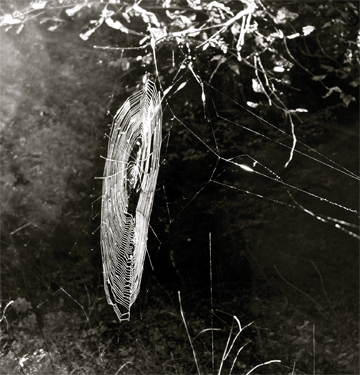
Beauty, in the Crum Woods, is also found in the small things including this spider web glistening in the sunlight.
With the help of research assistant Max Rennebohm ’13, George Lakey, research fellow at the Lang Center for Civic and Social Responsibility and visiting professor of peace and conflict studies, and his students are compiling a global database of nonviolent social and political actions. In the research seminar Strategy and Nonviolent Struggle, students search out examples of successful—and unsuccessful—nonviolent campaigns for human rights, democracy, environmental sustainability, economic justice, national or ethnic identity, and peace. They learn both quantitative and qualitative social research methods while studying strategies for nonviolent struggle and preparing narrative “cases” for the database—with the goal of having at least one case for every country in the world. Lakey says the as-yet-unfinished database, which will be hosted by Training for Change, “is an old dream of mine—for activists and scholars to be able to go to one place and read about other peoples’ experience of these things.”
And ecologist José-Luis Machado, associate professor of biology, is a co-founder of the brand-new Ecological Research as Education Network (EREN), a Web-based consortium of scientists at undergraduate institutions. With support from the National Science Foundation, Machado and his colleagues at 35 other colleges are developing small-scale ecological research projects that will achieve large-scale results by being repeated across a range of environments in 19 U.S. states and two Canadian provinces. The goal is to maximize student engagement in research while generating high quality publishable data. “We want to help students keep the big picture in mind, even though our own research arena—largely the Crum Woods—is small,” Machado says.
WHERE IDEAS MEET THE STREET
To end where we began, let’s return to Trotter Hall, where Keith Reeves’ Urban Underclass seminar is about to begin. Around the table are three African American, one Asian, one Puerto Rican, and six Caucasian students including a German. They represent majors and minors in English literature, sociology/anthropology, biology, art history, economics, educational studies, cognitive science, psychology, public policy, black studies, French, and—yes—political science.
Reeves is delighted at the mix of people, but particularly the variety of academic disciplines. “The students are able to offer their own discipline’s perspectives to some of the issues we grapple with. I learn a tremendous amount from them,” he says.
Community-based learning puts forth real-world situations and requires students to consider them not only theoretically but also by proposing practical solutions. It’s also an intellectual crucible that demands new ways of thinking—where ideas meet the street, and sometimes the street wins.
After sharing a dinner of Chinese food provided by Reeves, the group digs into the topic of the week—labor force participation and economic dislocation in jobless ghettos. Referring to the readings, they discuss the difference between merely being poor and being both poor and unemployed. It’s a world of difference, Reeves says.
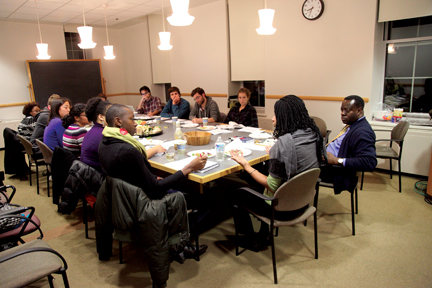
With a 24-page syllabus that includes seven books, weekly presentations, and a challenging final paper, Reeves’ course looks daunting. But the students are unfazed—and excited.
They investigate phenomena such as the emergence of drug-related activity; the challenges faced by single women serving as heads of households; the influence of freed prisoners on the ghetto neighborhoods where incarceration is seen as a “badge of honor”; and the reasons why immigrants with deficient language skills are more likely to be hired than African Americans. Reeves throws out questions that provoke rebuttal; the students often disagree but interact politely and articulately, always respectful of each other.
Shortly after 11:30 p.m., Reeves says he has one final question for the class: “The honors examiners will ask you this: ‘If you had to put together a public rhetoric on why you would work with some of these communities, how would you do it? How does one develop a rhetoric like that? What does it entail?’ We’ll grapple with that. Thanks for a wonderful discussion.”
The students rise from their seats, but instead of leaving, they cluster around Reeves with more questions. They’re not done yet. And he’s fine with that.
* The others are the evolving mission, values, and goals of a Swarthmore education; admissions, access, and affordability; and alumni engagement and development.
Editor’s Note: This article is the first of a series that will highlight the four areas of inquiry in the strategic planning process. Conversations around these topics, which are intended to be as wide-ranging and inclusive as possible, will culminate in a draft planning document in summer 2011. After this draft is presented to the Board of Managers in September, it will again be the subject of community discussions. It is expected that a final draft will be presented to the Board in December.
All members of the Swarthmore community are encouraged to participate. The College’s strategic planning website contains questions, documents, links to resources, and updates on the thinking of the various working groups charged with creating the plan. The site also presents many interactive opportunities to contribute to the thinking going on at the College. Find it all at http://sp.swarthmore.edu.
 Email This Page
Email This Page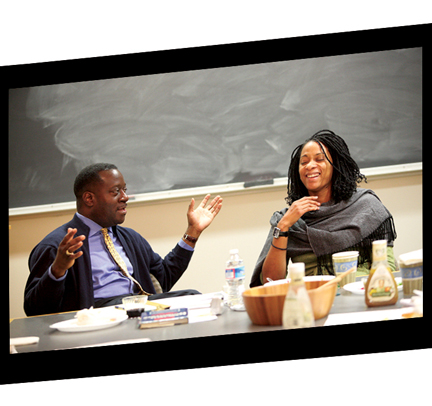
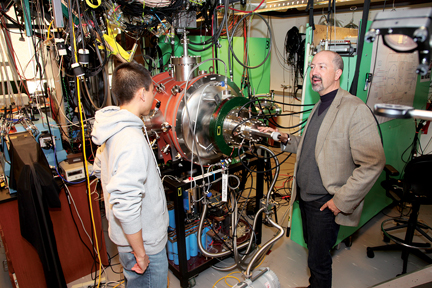

February 8th, 2011 3:59 pm
Digital stories and journal entries are publicly available on the blog for Writing Nature: Digital Storytelling. Craig Williamson's site on Old English Riddles offers riddle translations, commentary, and recorded performances of Professor Williamson singing the riddles.